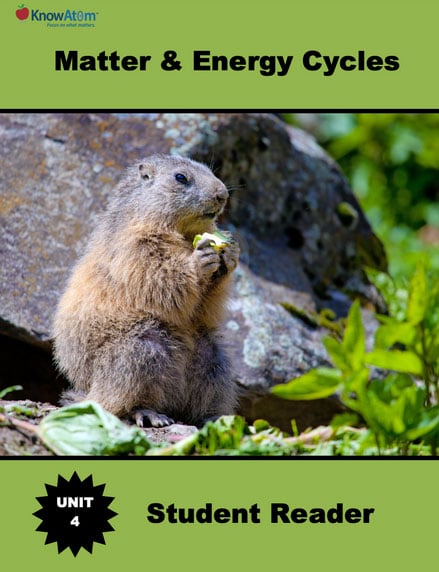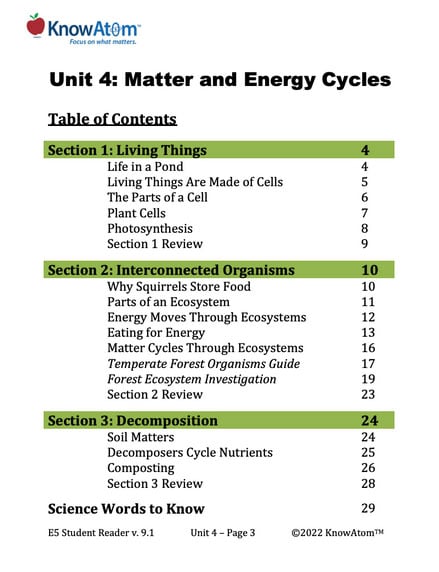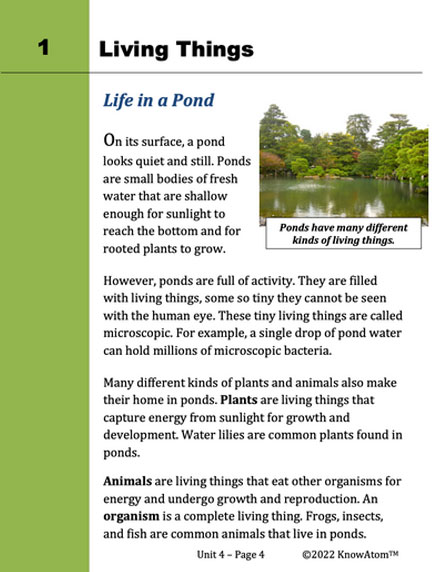In this lesson, students analyze how a plant’s structures allow it to capture the sun’s energy to transform water and carbon dioxide into oxygen and glucose, which it needs to grow and develop.
In this unit, students focus on the biosphere, analyzing how living things interact with one another and their environment for survival. In this lesson, students figure out the science phenomenon of how plants gather energy and nutrients. This page is a high-level extract of this lesson.
Science background gives teachers more in-depth information about the phenomena students explore in this unit on matter and energy cycles. Below is an excerpt from the science background information on plant growth.
Plants and animals have many similarities. Like all living things, plants and animals grow, develop, and reproduce.
Plant cells have certain structures that animal cells do not, including chloroplasts and a cell wall. They also respond and adapt to their environment. Finally, both are living things, so both need to obtain and use energy.
However, the way in which plants and animals obtain energy is different. As a result, plant cells and animal cells have a few key differences. Plant cells use energy from the sun to make their own food. They are able to do this because plant cells have chloroplasts, which contain a green pigment called chlorophyll. This pigment absorbs sunlight and gives plant cells their green color.
The sunlight absorbed by the chloroplasts begins the process of photosynthesis, which uses the sun’s energy to convert carbon dioxide and water into a kind of sugar called glucose, which the plant uses for energy.
Animals lack chloroplasts and do not photosynthesize, so they must consume plants or other animals for energy. Ninety percent of a plant cell is taken up by the central vacuole, which fills with water and waste from the cell. A plant wilts if its cells lose water in their central vacuoles.
Plant cells also have cell walls, which are stiff fibers that help plants stay rigid and stand up. Animal cells lack cell walls, so they are less rigid and therefore can take many different shapes. Plant cells contain a larger central vacuole than animal cells.
All ecosystems include living things; oxygen and carbon dioxide from the atmosphere; water; and energy from the sun.
Plants are essential parts of all ecosystems. An ecosystem is a community of different organisms that depend on interacting with each other and their physical environment for survival.
Plants are essential to all ecosystems because they are able to capture light energy from the sun and turn it into chemical energy in the form of glucose through photosynthesis. Chemical energy is energy stored in the bonds of atoms and molecules. The glucose produced in photosynthesis also provides the building blocks necessary for proteins, DNA, and all other parts cells need to grow and reproduce.
The leaves are important external structures in photosynthesis. Not only do the cells in plant leaves contain the most chloroplasts, but leaves are also where plants have stomata, which are pores that take in carbon dioxide from the environment and release oxygen. This exchange of gasses in plants is called respiration.
Plants also have roots, which gather water and nutrients from the soil. Roots hold the plant in the ground and withstand the forces of wind and moving water. As the plant grows upward, the roots prevent the plant from becoming unbalanced and toppling over. The stems transport water and nutrients between the roots and the rest of the plant.
Without sunlight, carbon dioxide, and water, plants would not be able to photosynthesize, and without photosynthesis, plants would die. During photosynthesis, plants transform matter that is not food, including air and water, into matter that is food, specifically glucose, allowing the plant to grow and develop.
In this lesson, students analyze how a plant’s structures allow it to capture the sun’s energy to transform water and carbon dioxide into oxygen and glucose, which it needs to grow and develop.

Prepared hands-on materials, full year grade-specific curriculum, and personalized live professional development designed to support mastery of current state science standards.
Ecosystem : a community of different organisms that depend on interacting with each other and their physical environment for survival
Function : the normal action of something or how something works
Inorganic : anything that is not living and never was living (e.g., water and rocks)
Nutrients : chemicals that organisms need for the growth and maintenance of cells
Organic : anything that is living or was once living (e.g., fallen leaves and animal remains)
Organism : a complete living thing
Photosynthesis : the process of turning sunlight, carbon dioxide, and water into glucose and oxygen
Plant : a living thing that captures energy from sunlight for growth and development
Soil : a mixture of broken-down rocks, decaying organic matter, and other materials that plants use to grow
Structure : the way in which parts are put together to form a whole
Plant Cells
Plant cells have cell walls in addition to a cell membrane. Cell walls are stiff fibers that help plants stay rigid and stand up. Animal cells lack cell walls, so they are less rigid. For this reason, animal cells can take many different shapes.
Plant cells have organelles called chloroplasts [klawr-uh-plasts]. Chloroplasts absorb energy from the sun to make their own food.
Chloroplasts contain a green pigment called chlorophyll. This pigment absorbs sunlight and gives plant cells their green color. The sunlight absorbed by the chloroplasts begins the process of photosynthesis. Photosynthesis uses the sun’s energy to convert carbon dioxide and water into a kind of sugar called glucose. Glucose holds stored chemical energy. Plants use glucose for growth and development.
Photosynthesis
Without sunlight, carbon dioxide, and water, plants would not be able to photosynthesize. During photosynthesis, plants transform matter that is not food, including air and water, into matter that is food, specifically glucose. Glucose contains chemical energy that allows the plant to grow and develop.
In addition to chloroplasts, which are found in the cells of a plant’s leaves, plants have other structures to perform photosynthesis. For example, leaves also have stomata, which are pores that open and close.
They take in carbon dioxide from the environment and release oxygen. This exchange of gasses in plants is called respiration. When plants take in carbon dioxide, not all of it is used for photosynthesis. Some of the carbon atoms become part of the plant as they are used for growth.
Plants also have roots to anchor the plant. Roots also gather water and minerals from the soil. Plants need different kinds of minerals, including nitrogen, phosphorus, and potassium. These nutrients help maintain the plants’ cells. The stems transport the water and minerals between the roots and the rest of the plant.



As the hands-on activity for this lesson, students figure out the connection between the phenomena of plant growth and development and environmental factors like nutrients. Students collect and analyze data from experiments they develop to analyze the influence of environmental factors on the height of plants and their structural appearance after 10 days of observations. Then, they use the data to construct an explanation for what a plant needs to grow and develop.
KnowAtom incorporates formative and summative assessments designed to make students thinking visible for deeper student-centered learning.

Standards citation: NGSS Lead States. 2013. Next Generation Science Standards: For States, By States. Washington, DC: The National Academies Press. Neither WestEd nor the lead states and partners that developed the Next Generation Science Standards were involved in the production of this product, and do not endorse it.